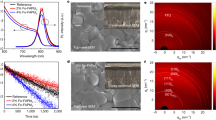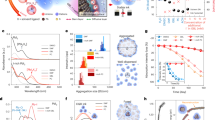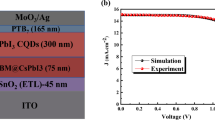Abstract
Quantum dot (QD) provides a versatile platform for high-throughput processing of semiconductors for large-area optoelectronic applications. Unfortunately, the QD solar cell is hampered by the time-consuming layer-by-layer process, a major challenge in manufacturing printable devices. Here we demonstrate a sequential acylation-coordination protocol including amine-assisted ligand removal and Lewis base-coordinated surface restoration to synthesize conductive APbI3 (A = formamidinium (FA), Cs or methylammonium) colloidal perovskite QD (PeQD) inks that enable one-step PeQD film deposition without additional solid-state ligand exchange. The resultant PeQD film displays uniform morphology with elevated electronic coupling, more ordered structure and homogeneous energy landscape. Narrow-bandgap FAPbI3 PeQD-based solar cells achieve a champion efficiency of 16.61% (certified 16.20%), exceeding the values obtained with other QD inks and layer-by-layer processes. The conductive PeQD inks are compatible with large-area device (9 × 9 cm2) fabrication using the blade-coating technique with a speed up to 50 mm s−1.
This is a preview of subscription content, access via your institution
Access options
Access Nature and 54 other Nature Portfolio journals
Get Nature+, our best-value online-access subscription
27,99 € / 30 days
cancel any time
Subscribe to this journal
Receive 12 digital issues and online access to articles
118,99 € per year
only 9,92 € per issue
Buy this article
- Purchase on SpringerLink
- Instant access to full article PDF
Prices may be subject to local taxes which are calculated during checkout





Similar content being viewed by others
Data availability
The data that support the plots within this paper and other findings of this study are available from the corresponding author upon reasonable request. Source data are provided with this paper.
References
Kovalenko, M. V. Opportunities and challenges for quantum dot photovoltaics. Nat. Nanotechnol. 10, 994–997 (2015).
Swarnkar, A. et al. Quantum dot-induced phase stabilization of α-CsPbI3 perovskite for high-efficiency photovoltaics. Science 354, 92–95 (2016).
Chen, Y. et al. Multiple exciton generation in tin–lead halide perovskite nanocrystals for photocurrent quantum efficiency enhancement. Nat. Photon. 16, 485–490 (2022).
Semonin, O. E. et al. Peak external photocurrent quantum efficiency exceeding 100% via MEG in a quantum dot solar cell. Science 334, 1530–1533 (2011).
Yuan, M. et al. Colloidal quantum dot solids for solution-processed solar cells. Nat. Energy 1, 16016 (2016).
Jia, D. et al. Tailoring solvent-mediated ligand exchange for CsPbI3 perovskite quantum dot solar cells with efficiency exceeding 16.5%. Joule 6, 1632–1653 (2022).
Jia, D. et al. Inhibiting lattice distortion of CsPbI3 perovskite quantum dots for solar cells with efficiency over 16.6%. Energy Environ. Sci. 15, 4201–4212 (2022).
Shi, J. et al. In situ iodide passivation toward efficient CsPbI3 perovskite quantum dot solar cells. Nano Micro Lett. 15, 163 (2023).
Zhao, Q. et al. High efficiency perovskite quantum dot solar cells with charge separating heterostructure. Nat. Commun. 10, 2842 (2019).
Hao, M. et al. Ligand-assisted cation-exchange engineering for high-efficiency colloidal Cs1−xFAxPbI3 quantum dot solar cells with reduced phase segregation. Nat. Energy 5, 79–88 (2020).
Jia, D. et al. Antisolvent-assisted in situ cation exchange of perovskite quantum dots for efficient solar cells. Adv. Mater. 35, e2212160 (2023).
Aqoma, H. et al. Alkyl ammonium iodide-based ligand exchange strategy for high-efficiency organic-cation perovskite quantum dot solar cells. Nat. Energy 9, 324–332 (2024).
Sun, B. et al. Monolayer perovskite bridges enable strong quantum dot coupling for efficient solar cells. Joule 4, 1–15 (2020).
Kim, H. I. et al. A tuned alternating D–A copolymer hole-transport layer enables colloidal quantum dot solar cells with superior fill factor and efficiency. Adv. Mater. 32, 2004985 (2020).
Zhao, Q. et al. Colloidal quantum dot solar cells: progressive deposition techniques and future prospects on large-area fabrication. Adv. Mater. 34, e2107888 (2022).
Yuan, J. et al. Metal Halide perovskites in quantum dot solar cells: progress and prospects. Joule 4, 1–26 (2020).
Ling, X. et al. The rise of colloidal lead halide perovskite quantum dot solar cells. Acc. Mater. Res. 3, 866–878 (2022).
Wang, Y. et al. Room-temperature direct synthesis of semi-conductive PbS nanocrystal inks for optoelectronic applications. Nat. Commun. 10, 5136 (2019).
Akkerman, Q. A. et al. Genesis, challenges and opportunities for colloidal lead halide perovskite nanocrystals. Nat. Mater. 17, 394–405 (2018).
Almeida, G. et al. Resurfacing halide perovskite nanocrystals. Science 364, 833–834 (2019).
Kim, J. et al. Single-step-fabricated perovskite quantum dot photovoltaic absorbers enabled by surface ligand manipulation. Chem. Eng. J. 448, 137672 (2022).
Song, H. et al. A universal perovskite nanocrystal ink for high-performance optoelectronic devices. Adv. Mater. 35, e2209486 (2023).
Xue, J. et al. Surface ligand management for stable FAPbI3 perovskite quantum dot solar cells. Joule 2, 1866–1878 (2018).
Hoshi, K. et al. Purification of perovskite quantum dots using low-dielectric-constant washing solvent ‘Diglyme’ for highly efficient light-emitting devices. ACS Appl. Mater. Interfaces 10, 24607–24612 (2018).
Wang, Y. et al. Surface ligand management aided by a secondary amine enables increased synthesis yield of CsPbI3 perovskite quantum dots and high photovoltaic performance. Adv. Mater. 32, e2000449 (2020).
Li, C. et al. Rational design of Lewis base molecules for stable and efficient inverted perovskite solar cells. Science 379, 690–694 (2023).
Xue, J. et al. The surface of halide perovskites from nano to bulk. Nat. Rev. Mater. 5, 809–827 (2020).
Zhang, X. et al. Ligand-assisted coupling manipulation for efficient and stable FAPbI3 colloidal quantum dot solar cells. Angew. Chem. Int. Ed. 62, e202214241 (2023).
Li, F. et al. Solution‐Mediated hybrid FAPbI3 perovskite quantum dots for over 15% efficient solar cell. Adv. Funct. Mater. 33, 2302542 (2023).
Liu, F. et al. Highly luminescent phase-stable CsPbI3 perovskite quantum dots achieving near 100% absolute photoluminescence quantum yield. ACS Nano 11, 10373–10383 (2017).
deQuilettes, D. W. et al. Photoluminescence lifetimes exceeding 8 μs and quantum yields exceeding 30% in hybrid perovskite thin films by ligand passivation. ACS Energy Lett. 1, 438–444 (2016).
Huang, H. et al. High-efficiency perovskite quantum dot photovoltaic with homogeneous structure and energy landscape. Adv. Funct. Mater. 33, 2210728 (2023).
Zhang, X. et al. Homojunction perovskite quantum dot solar cells with over 1 μm-thick photoactive layer. Adv. Mater. 34, e2105977 (2022).
de Weerd, C. et al. Efficient carrier multiplication in CsPbI3 perovskite nanocrystals. Nat. Commun. 9, 4199 (2018).
Hu, L. et al. Flexible and efficient perovskite quantum dot solar cells via hybrid interfacial architecture. Nat. Commun. 12, 466 (2021).
Liu, M. et al. Hybrid organic-inorganic inks flatten the energy landscape in colloidal quantum dot solids. Nat. Mater. 16, 258–263 (2017).
Li, F. et al. Hydrogen-bond-bridged intermediate for perovskite solar cells with enhanced efficiency and stability. Nat. Photon. 17, 478–484 (2023).
Zheng, X. et al. Defect passivation in hybrid perovskite solar cells using quaternary ammonium halide anions and cations. Nat. Energy 2, 17102 (2017).
Ni, Z. et al. Evolution of defects during the degradation of metal halide perovskite solar cells under reverse bias and illumination. Nat. Energy 7, 65–73 (2021).
Ni, Z. et al. Resolving spatial and energetic distributions of trap states in metal halide perovskite solar cells. Science 367, 1352–1358 (2020).
Wu, Y. et al. Stable perovskite solar cells with 25.17% efficiency enabled by improving crystallization and passivating defects synergistically. Energy Environ. Sci. 15, 4700–4709 (2022).
Jiang, Q. et al. Surface passivation of perovskite film for efficient solar cells. Nat. Photon. 13, 460–466 (2019).
Jia, D. et al. Surface matrix curing of inorganic CsPbI3 perovskite quantum dots for solar cells with efficiency over 16%. Energy Environ. Sci. 14, 4599–4609 (2021).
Deng, Y. et al. Surfactant-controlled ink drying enables high-speed deposition of perovskite films for efficient photovoltaic modules. Nat. Energy 3, 560–566 (2018).
Huang, H. et al. Controllable colloidal synthesis of MAPbI3 perovskite nanocrystals for dual-mode optoelectronic applications. Nano Lett. 23, 9143–9150 (2023).
Kresse, G. et al. Efficient iterative schemes for ab initio total-energy calculations using a plane-wave basis set. Phys. Rev. B 54, 11169 (1996).
Perdew, J. et al. Generalized gradient approximation made simple. Phys. Rev. Lett. 77, 3865 (1996).
Blöchl, P. et al. Projector augmented-wave method. Phys. Rev. B 50, 17953 (1994).
Grimme, S. et al. Effect of the damping function in dispersion corrected density functional theory. J. Comput. Chem. 32, 1456–1465 (2011).
Liu, M. et al. Hybrid organic-inorganic inks flatten the energy landscape in colloidal quantum dot solids. Nat. Mater. 16, 258–263 (2016).
Yang, Z. et al. Mixed-quantum-dot solar cells. Nat. Commun. 8, 1325 (2017).
Xu, J. et al. 2D matrix engineering for homogeneous quantum dot coupling in photovoltaic solids. Nat. Nanotechnol. 13, 456–462 (2018).
Liu, M. et al. Lattice anchoring stabilizes solution-processed semiconductors. Nature 570, 96–101 (2019).
Baek, S.-W. et al. Efficient hybrid colloidal quantum dot/organic solar cells mediated by near-infrared sensitizing small molecules. Nat. Energy 4, 969–976 (2019).
Ding, C. et al. Over 15% efficiency PbS quantum‐dot solar cells by synergistic effects of three interface engineering: reducing nonradiative recombination and balancing charge carrier extraction. Adv. Energy Mater. 12, 2201676 (2022).
Ahmad, W. et al. Lead selenide (PbSe) colloidal quantum dot solar cells with >10% efficiency. Adv. Mater. 31, 1900593 (2019).
Fang, S. et al. Open-shell diradical-sensitized electron transport layer for high-performance colloidal quantum dot solar cells. Adv. Mater. 35, 2212184 (2023).
Liu, Y. et al. PbSe quantum dot solar cells based on directly synthesized semiconductive inks. ACS Energy Lett. 5, 3797–3803 (2020).
Akkerman, Q. A. et al. Strongly emissive perovskite nanocrystal inks for high-voltage solar cells. Nat. Energy 2, 16194 (2016).
Acknowledgements
This work was financially supported by the National Key Research and Development Program of China (no. 2023YFE0210000) (J.Y.), the National Natural Science Foundation of China (no. 52261145696) (J.Y.), China National Postdoctoral Program for Innovative Talents (BX20230255) (X.Z.), China Postdoctoral Science Foundation (2023M742527) (X.Z.), Natural Science Foundation of Jiangsu Province (BK20211598) (J.Y.) and Jiangsu Funding Program for Excellent Postdoctoral Talent (2023ZB405) (X.Z.), ‘111’ project, Collaborative Innovation Center of Suzhou Nano Science and Technology, Soochow University. This work was partly supported by the National Research Foundation of Korea (NRF) grants funded by the Korean government (MSIT) (no. 2020R1A2C2005844) (D.-H.K.).
Author information
Authors and Affiliations
Contributions
X.Z. and J.Y. conceived the project, and W.M. and J.Y. supervised the project. X.Z., H.H. and C.Z. synthesized the FAPbI3, MAPbI3 and CsPbI3 PeQDs, respectively. X.Z. fabricated the PeQD inks, PeQD films and devices and conducted most of the characterizations and experimental analysis. H.H. and C.Z conducted the TEM, DLS and NMR characterizations. L.J. performed the DFT simulations supervised by Y.L. C.L. conducted the GISAXS measurements supervised by D.-H.K. X.Z. drafted the manuscript and revised the manuscript with help from T.W., W.M. and J.Y. All the authors reviewed the paper.
Corresponding authors
Ethics declarations
Competing interests
The authors declare no competing interests.
Peer review
Peer review information
Nature Energy thanks Guoran Li, Lianzhou Wang and the other, anonymous, reviewer(s) for their contribution to the peer review of this work.
Additional information
Publisher’s note Springer Nature remains neutral with regard to jurisdictional claims in published maps and institutional affiliations.
Supplementary information
Supplementary Information
Supplementary Figs. 1–31, Tables 1–4 and Note 1.
Supplementary Data 1
Source data for Supplementary Figs. 18 and 22.
Source data
Source Data Fig. 1
DLS, FTIR, NMR and Pb 4f spectra source data.
Source Data Fig. 2
Azimuthal integration data extracted from GIWAXS and in-plane line-cuts data extracted from GISAXS.
Source Data Fig. 3
TA mapping source data, current intensity distribution data extracted from c-AFM, and SCLC source data.
Source Data Fig. 4
Device performance source data.
Source Data Fig. 5
PL emission and PL lifetime maps source data and device performance data of large-area PQD films.
Rights and permissions
Springer Nature or its licensor (e.g. a society or other partner) holds exclusive rights to this article under a publishing agreement with the author(s) or other rightsholder(s); author self-archiving of the accepted manuscript version of this article is solely governed by the terms of such publishing agreement and applicable law.
About this article
Cite this article
Zhang, X., Huang, H., Zhao, C. et al. Conductive colloidal perovskite quantum dot inks towards fast printing of solar cells. Nat Energy 9, 1378–1387 (2024). https://doi.org/10.1038/s41560-024-01608-5
Received:
Accepted:
Published:
Issue Date:
DOI: https://doi.org/10.1038/s41560-024-01608-5
This article is cited by
-
Computationally guided defect-suppressing synthesis of luminescent tin halide perovskite nanocrystals
Nature Synthesis (2025)
-
Ligand Engineering Achieves Suppression of Temperature Quenching in Pure Green Perovskite Nanocrystals for Efficient and Thermostable Electroluminescence
Nano-Micro Letters (2025)



